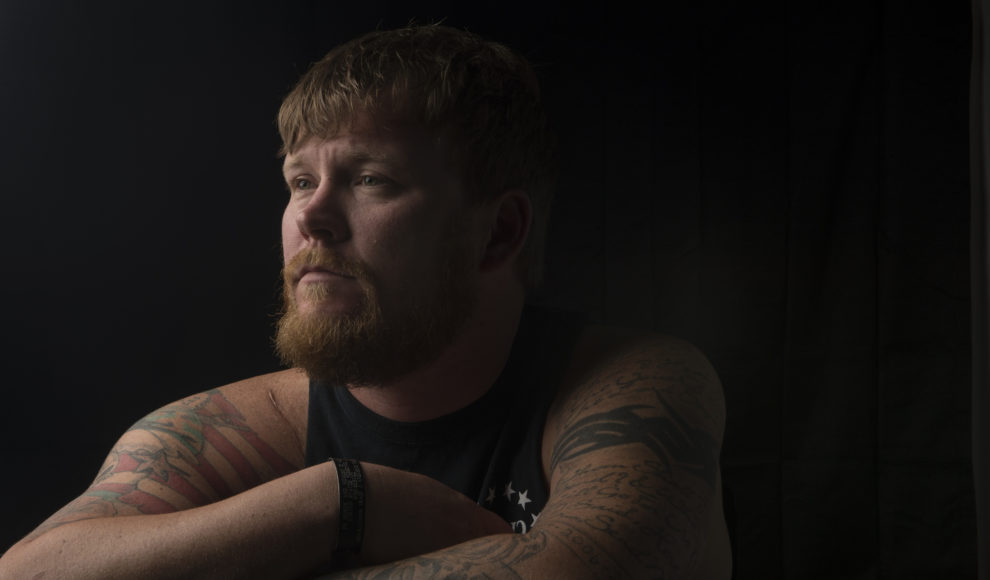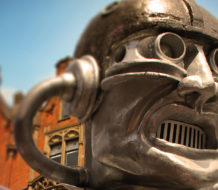When my son died by suicide in 2008, well-meaning friends sent me a variety of books on grief. I couldn’t stomach most of them. I was in shock and deeply traumatized by what had happened. I knew something had gone terribly wrong to transform my child from a boy with a sunny disposition into a hopeless young man who saw no way out of his anguish aside from death. Spiritual platitudes were no antidote for what ailed me.
He had experienced spiritual betrayal in two high-profile evangelical Christian contexts, which alienated him from his own cherished values, leaving him spiritually adrift. There were other complex issues, including serious health challenges, but I was convinced he had been suffering from something like posttraumatic stress disorder (PTSD).
Additionally, the only language I could find for what my husband, my surviving son, and I were going through in the aftermath of the suicide was the language of PTSD because the suicide followed close behind our experience of being whistleblowers at a famous California megachurch. I read one short book on suicide loss and then Judith Herman’s Trauma and Recovery: The Aftermath of Violence—From Domestic Abuse to Political Terror. It’s still on my bookshelf.
PTSD is a medical diagnosis, a condition that more than one therapist has told me I don’t have. But they have all agreed that I’ve been through significant trauma and have suffered chronic stress over the past decade, which has taken its toll. A few years ago, when I first began hearing about a trauma response called “moral injury,” I knew I had landed on the description I had been looking for to explain some of what had happened to my family and me.
Diagnosing Moral Injury
The phrase “moral injury” was first coined in the 1990s by medical practitioners who were treating veterans for symptoms that didn’t fit the PTSD diagnosis. Over time, moral injury has come to be used to describe reactions to domestic, spiritual, and sexual abuse or assault as well as systemic racism and gang violence. The U.S. Department of Veterans Affairs defines it like this:
Like psychological trauma, moral injury is a construct that describes extreme and unprecedented life experience including the harmful aftermath of exposure to such events. Events are considered morally injurious if they “transgress deeply held moral beliefs and expectations.” Thus, the key precondition for moral injury is an act of transgression, which shatters moral and ethical expectations that are rooted in religious or spiritual beliefs, or culture-based, organizational, and group-based rules about fairness, the value of life, and so forth.
Whether it’s medicine, law enforcement, or another profession that involves “working in conditions of extremity,” there can be moral injury, said Rita Nakashima Brock, senior vice president in charge of moral injury programs at Volunteers of America and co-author of Soul Repair: Recovering from Moral Injury after War.
Soldiers are trained to survive conditions of violence and extremity far better than the rest of us, but they can still be devastated by those experiences. As Brock puts it:
The reason [veterans] have so much trouble unpacking what happened to them in relation to moral injury is that they are conditioned by ritual training in military behaviors and adaptations, including repressing vulnerability and harm, and not just consciously. It is deeply engrained in the body system in training … if you think, you’re too slow and you’re dead.
Much of what Judith Herman talked about in her book actually relates to moral injury, according to Brock. But moral injury wasn’t well known in 1997 when the book was published. However, Herman did articulate the kinds of conditions that contribute to moral injury, such as accusations that a victim is lying or a sense of betrayal by a trusted leader.
For me, what resonated most in Herman’s book was a passage in which she talks about coming to a fair assessment of one’s self and one’s culpability in a given situation. I was consumed by guilt and a sense of having failed my son after his suicide, in part because of the impact my involvement in confronting corruption in the megachurch had on my family. With time and effort — it took two years — I was able to gain perspective. One day as I was tending my son’s grave and telling him how sorry I was to have failed him, it struck me that I had spent every day of a quarter century trying to do right by him. Whatever my failings had been, they were unintentional; I had only intentionally loved him.
For James Higginbotham, an associate professor of Pastoral Care and Counseling at Earlham School of Religion, the concept of moral injury became an important outworking of his pastoral care work and pacifism. His religious body, the Disciples Peace Fellowship, had sponsored a resolution condemning the war in Iraq in 2007. Veterans felt that the resolution communicated condemnation and a lack of concern for them. Higginbotham was on the DPF Executive Committee at the time and dealt with the backlash for several years. He came to realize that there are many victims of war, including service members who can be injured physically, emotionally, spiritually, or morally by their combat experiences. “Shouldn’t congregations and pastors and others be concerned about the damage that war does to everyone, including those who fight?”
Spirituality and Recovery
Moral injury has long been confused with PTSD. The reason, Brock said, is that most research into the topic has been conducted on veterans, for whom the PTSD diagnosis has been important. The VA clinical community first recognized moral injury as a factor in veteran mental health, but didn’t know how to treat it, Brock told me. A treatment protocol was developed, but it was crisis intervention rather than a long-term approach to moral injury.
Zachary Moon is assistant professor of practical theology at Chicago Theological Seminary and a former military chaplain in a PTSD recovery unit. He points out that moral stress exists on a continuum, with moral injury representing the most radical form of moral stress, just as PTSD represents the most radical disordered state or condition related to post traumatic stress (PTS). “Human beings have different resources for coping and recovering; not everyone who has a traumatic experience develops PTSD. But we can still talk about PTS with that person,” he said. In the same way, he suggests, moral stress may not result in the most radical form of moral injury, but it is crucial to talk about in order to increase responsiveness and healthy coping in the aftermath of morally stressful experiences. Here spiritual rituals can be helpful as part of the healing process. For veterans, in particular, religious communities can also become a part of the homecoming process, according to Moon.
Sufferers may feel far from God or their community, and so may want to look to their own traditions for solace. For instance, within the Christian tradition, those suffering from moral injury may find that the Eucharist or communion table rituals — which talk about betrayal, suffering, pain, but also lead to reconnection with God — can facilitate recovery. The same can be true for sweat lodges, small structures originally used by some First Nations communities for purification ceremonies, which have been appropriated by outsiders because of the vitality of the process. For members of First Nation communities, who are overrepresented in the military, the sweat lodge can be a restorative experience, especially by providing an opportunity to name and alleviate the burdens that those who experience moral injury. “When it’s done in a culturally appropriate way, it’s very significant,” said Moon. “Reconnection and restoration within the fabric of the community is a central piece of that.”
What spiritual and religious rituals provide is a structure for talking about moral injury that can help people from feeling like it will take over their lives, according to Brock. But while a benevolent moral authority may be important for recovery, it can be a long road back to trusting spiritual authority for many who have suffered moral injury.
The first step toward recovery is accessing the memories and being able to tell the story enough times that the person experiencing moral injury can gain perspective on their experience. Moon says that demonstrating openness and compassion along with active listening are essential in ministering to a person who is suffering from moral injury. “As a chaplain, I’m hanging in there with you, and God, however you understand God, is hanging in there with you too.” Coming to terms with “moral emotions like guilt, shame, contempt, and disgust” helps us to get “back into right relationship within our community.”
This is why it’s important to go beyond crisis-oriented pastoral care when broaching the subject of moral injury with a congregant, says Higginbotham. “We have to be sensitive and look for the broad dimensions of woundedness that can be present, such as trauma and unknown moral dimensions and moral injuries that exist in people’s lives.”
Higginbotham’s colleague Nancy Bowen, a professor of Old Testament, has developed an innovative approach, drawing on knowledge about PTSD to illuminate her study of biblical text. For example, consider the story in Genesis 19, in which Lot’s daughters have sex with their father. Bowen traces this moral violation back to Genesis 14, where there is a war and Lot is taken captive. Here the men of Sodom demand to “know” Lot’s guests and as the family escapes, his wife defies instruction, turning back to look at the city, and is turned into pillar of salt. The family is deeply traumatized and her action could be seen as a successful suicide attempt rather than simple rebellion. Similarly, the story of Ruth can be read as a story of moral repair. The scene between Ruth and Boaz on the threshing floor uses the same Hebrew language as the story of Lot and his daughters.
“To be able to hear the story of moral injury without censure, blame, or judgement is a key part of the moral repair,” Bowen says. Reading Scripture through this lens can bring a new level of compassion not only for the biblical characters but for ourselves.
Ever since my son died, I’ve thought that Job’s wife gets a bad rap for telling him to curse God and die after their children died. Although I am no longer angry at God for what felt like a betrayal, I do understand her grief.
Building Resilience
For many veterans, service is a core value, but those who have experienced moral stress and injury may be suffering from a “disorientation around meaning,” according to Moon. Beyond directly addressing moral injury in sacred rituals and counseling sessions, inviting veterans into community service can be especially powerful because it allows them to contribute their strengths to the community, rather treating them like there is something wrong with them. “Sitting on a couch is not how you’re going to get well,” Moon said.
Perhaps this is why so many trauma survivors like me find participation in activism around their particular trauma so vital to the healing process. While we can’t make sense of what happened to us or our loved ones, we still need to do something.
There is a difference between chronic stress and traumatic stress, however. At Eastern Mennonite University’s Center for Justice and Peace Building, learning to understand that difference is the first step in a training program called Strategies for Trauma Awareness and Resilience (STAR), said director Katie Mansfield.
It is a three-part program, which begins by exploring why we can’t just “get over it.” Mansfield points out that “there are very real reasons in terms of our neurobiology and our physiology as well as our beliefs that we cannot just get over it.” The second step probes why we get trapped in unhealed trauma and cycles of violence, impacting both ourselves and others. Third is the physical, emotional, and spiritual processes for building resilience, as well as social and political processes for engaging and addressing the needs that come out of traumatic events.
Mansfield outlined additional modes of moral injury, including perpetration-induced traumatic stress. This can occur when a person — such as a soldier, a gang member, or a domestic abuser — is directly involved in doing harm to another and then exhibits a trauma response. Sexual abuse typically happens at the hands of someone we know and trust. And “just like the person in the military or in the gang is trusting the system that has put him or her to work, someone on the receiving end of sexual abuse is also usually trusting the person who is involving them in this harm,” Mansfield points out. In both cases there is a kind of deeply embodied participation — the people responsible for including harm carry with them a sense of having participated in deep wrongdoing and feel a sense of culpability for it. This is true even of abuse and assault survivors. As Mansfield puts it:
There is something in the deep stigmatizing in what happens in body, brain, belief, and behavior that opens up the possibility for change. One of the most important things we do is to destigmatize the very natural array of responses that happen in people’s brains, bodies, beliefs, and behaviors.
Destigmatizing can be facilitated by naming things. While PTSD gets a lot of press and is an important diagnosis, not all trauma impacts are PTSD. Thus, she thinks, it’s important to broaden the conversation beyond the medical diagnosis of PTSD to understanding what cultural trauma looks like.
Mansfield was in New York City on September 11, 2001 and lost loved ones that day. “I who had been an overachiever and a long-term planner who would make plans two years in advance, was suddenly unable to look more than five days into the future.” Later she became physically ill after seeing a friend get seriously injured in a car accident. As she was vomiting outside the emergency room, she thought it was something she ate. Another friend had to point out to her that the cause was not not food poisoning but trauma.
In STAR training, cohorts of twenty or so attendees are invited to talk about what kinds of trauma they have witnessed or experienced, without having to go into excessive detail. “As we unfold what’s going on in the brain and the body, we unpack what is the protective impulse that makes the body do these things,” said Mansfield. Getting sick, becoming hyper alert or lazy and sluggish — all of these extreme sensations (or lack thereof) are natural responses to trauma.
The good news is that recovery is possible and symptoms don’t have to last forever. According to Mansfield, emotional release tools, such as massage, yoga, running, being outside in nature, making art, all help bodies and minds recover. It’s also important to address the social needs that emerge when people have experienced traumatic events and moral injury. Cycles of violence must be named and acknowledged. Restorative justice programs in court systems are a good way of addressing communal trauma. Here the humanity of the victims as well as the responsible parties is taken seriously, as are the needs of the impacted communities. “Whether it’s the historical harms of the legacy of slavery in this country or a natural disaster, there are lots of tools that we can engage in body, mind, and spirit and socially to meet the needs that are created by traumagenic events,” Mansfield observes.
Participants in STAR training don’t just sit in a classroom listening to lectures. They engage body, mind, and spirit in a learning journey so that after five days, they often experience a substantial shift in their overall wellbeing and what they think they have to bring back to their lives and communities, she said. The program is not one for recent trauma victims, and it should not be confused with counseling. Instead, it is for people who have profound questions and recognize that they are positioned in their communities to bring about awareness and deeper resilience. Participants range from religious leaders and mental and physical health workers to peace and development workers as well as those addressing systematic racism and military support personnel. Higginbotham attended a STAR training and said it is one of the best strategies for addressing moral injury.
For me, the primary sources of chronic stress are my roles as the spouse of a physically disabled husband and a mother of a mentally ill adult son. When medical crises arise with them, I often feel re-traumatized. “No matter what position or role we hold, there is also secondary trauma or what some people call compassion fatigue,” said Mansfield. As she puts it:
Whatever position you are in, if you are working to support people who are dealing with either one-time events that they’ve been through that they have not found a way to process or ongoing chronic harm, we even as care-givers, support people, and witnesses can also exhibit a trauma response.
Spend time talking about that and about tools that we can use to assess our own standing — whether we are experiencing compassion fatigue or compassion satisfaction. The first step is to come to terms with where we’re at.












Dear Christine, I am SO THANKFUL that I got to sit next to you are lunch on the balcony over the Frio. You are a blessing and a delight. Thank you for sharing this information. It makes sense, it clicked. Insight, while often painful, moves stumbling blocks. Thank you, Gwen